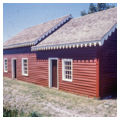In the 1840s, Métis fur trader Antoine Blanc Gingras joined the American fur trading partnership founded by Norman Kittson and Henry Sibley to compete in a trade war with the British Hudson’s Bay Company, a conflict that influenced the foreign policies of the United States and Great Britain. Because of Gingras’s activities, the former Hudson’s Bay Company trade route shifted from its northern path through Fort Gary in Winnipeg to a southern one through St. Paul. This change warranted huge tariff revenues for the United States and firmly established the nation’s economic and political control over the border region.
Two reconstructed buildings on the site— the trading store and the Gingras house—are among the few tangible remains of the fur trade era in the valley of the Red River of the North. Both buildings are one-and-a-half stories high and constructed of square hewn oak logs dovetailed at the corners, blending the classic American log cabin with French Canadian building methods. The buildings are also of locally uncommon pièce-en-terre and pièce-sur-sol construction.


















